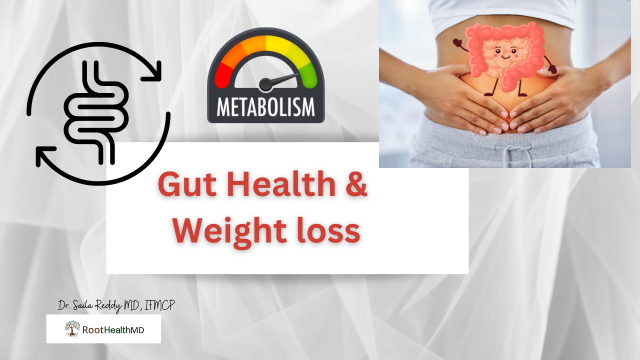
Sustained weight loss: Through Whole Body Healing
The Role of Healing the Body in Weight loss
- Healing metabolic dysfunction through targeted strategies is essential for lasting results:
- Gut health: The microbiome’s role in metabolism and cravings.
- Detox pathways: Removing environmental toxins and supporting liver health.
- Inflammation reduction: The impact of chronic inflammation on insulin resistance and fat storage.
The Role of Healing the Body: A Foundation for Lasting Weight Loss
Healing metabolic dysfunction requires more than simply focusing on calorie intake or exercising more. Achieving lasting weight loss and metabolic health involves addressing the underlying causes of metabolic imbalances that prevent the body from functioning optimally. Healing the body through targeted strategies—such as supporting gut health, improving detox pathways, and reducing inflammation—helps restore balance and empowers the body to release weight naturally and sustainably.
1. Gut Health: The Microbiome’s Role in Metabolism and Cravings
The gut microbiome—the trillions of bacteria, viruses, and fungi residing in your digestive tract—plays a central role in metabolism, energy regulation, and overall health. Emerging research continues to uncover how the gut microbiome influences hormonal balance, appetite regulation, and nutrient absorption, all of which impact weight management. Here’s how a healthy microbiome supports metabolic function:
- Metabolism and Nutrient Absorption:
A balanced gut microbiome is essential for breaking down food and absorbing nutrients efficiently. When the microbiome is out of balance, the gut may struggle to extract key nutrients, leading to malabsorption and metabolic inefficiency. This can result in the body storing excess fat, despite consuming adequate calories. Certain gut bacteria help metabolize food, especially complex carbohydrates, fiber, and proteins, promoting the optimal breakdown of macronutrients for energy. - Cravings and Hunger Signals:
The gut microbiome also affects hunger hormones, like ghrelin and leptin, which regulate appetite and satiety. An imbalance in gut bacteria, often caused by poor diet, antibiotics, or stress, can trigger cravings for sugary or high-carb foods. When the microbiome is out of balance, it may send signals to the brain that encourage overeating and sugar cravings. A healthy microbiome, on the other hand, encourages the release of hormones that signal fullness and prevent overeating. - Gut Health and Insulin Sensitivity:
A healthy gut microbiome plays a role in insulin sensitivity, meaning it helps your cells effectively respond to insulin. A dysregulated microbiome can contribute to insulin resistance, a condition where the body’s cells no longer respond to insulin properly, leading to higher blood sugar and fat storage. Supporting the microbiome with prebiotics, probiotics, and fiber can help restore insulin sensitivity, reduce blood sugar levels, and promote healthier weight regulation.
2. Detox Pathways: Removing Environmental Toxins and Supporting Liver Health
Our bodies are constantly exposed to environmental toxins, such as pesticides, heavy metals, pollutants, and chemicals in food, water, and air. These toxins can accumulate in the body over time, overwhelming detoxification systems, particularly the liver, which is the body’s primary detox organ. This burden on the liver and detox pathways can disrupt metabolism in several ways:
- Toxin Storage and Fat Accumulation:
When the liver is overloaded with toxins, it struggles to perform its role in processing and eliminating waste. As a result, the body stores many of these toxins in fat cells as a protective mechanism. This leads to increased fat storage, particularly in areas like the abdomen. The more toxins the body stores, the harder it becomes for the liver to detoxify and metabolize fat. This creates a vicious cycle of fat retention and toxin accumulation. - Supporting Liver Health for Metabolic Function:
To heal metabolic dysfunction, it is essential to support the liver and detoxification pathways. A clean, well-functioning liver can help clear out accumulated toxins and reset metabolism. Supporting liver function through hydration, liver-supportive foods (like cruciferous vegetables, beets, and turmeric), and detoxification protocols(such as intermittent fasting or saunas) can help the liver perform its job efficiently, allowing the body to naturally release fat and improve metabolic health. - Environmental Toxins and Insulin Resistance:
Many environmental toxins, such as endocrine disruptors, can interfere with hormone regulation. These toxins mimic or block the action of hormones like insulin, disrupting their normal function and leading to insulin resistance. For example, bisphenol A (BPA), commonly found in plastics, has been linked to increased fat storage and impaired glucose metabolism. Detoxifying from these harmful chemicals is key to restoring metabolic function and improving insulin sensitivity.
3. Inflammation Reduction: The Impact of Chronic Inflammation on Insulin Resistance and Fat Storage
Chronic inflammation is a silent driver of metabolic dysfunction and a key contributor to insulin resistance, fat storage, and weight gain. When inflammation becomes persistent—often as a result of poor diet, environmental toxins, or chronic stress—it can impair the body’s ability to process nutrients, burn fat, and regulate blood sugar. Here’s how inflammation impacts metabolism:
- Insulin Resistance and Inflammation:
Chronic inflammation damages the body’s ability to respond to insulin, leading to insulin resistance. Inflammation interferes with insulin signaling pathways, preventing glucose from entering the cells and forcing the body to store excess glucose as fat. Over time, this leads to higher blood sugar levels and increased fat storage. Inflammation also impairs the fat-burning processes, making it harder for the body to release stored fat. - Inflammation and Visceral Fat:
Inflammation plays a significant role in the accumulation of visceral fat—the type of fat stored around the organs, particularly in the abdomen. Visceral fat is closely linked to metabolic syndrome, a group of conditions that increase the risk of heart disease, type 2 diabetes, and stroke. Reducing inflammation can help shift the body away from storing visceral fat and towards burning fat for energy. - Reducing Inflammation for Better Metabolism:
Reducing inflammation is essential for restoring metabolic function. Anti-inflammatory strategies such as eating a diet rich in anti-inflammatory foods (e.g., omega-3-rich fish, leafy greens, turmeric, and ginger), practicing stress management techniques (like meditation or yoga), and improving sleep quality can help lower inflammation levels in the body. When inflammation is reduced, the body becomes more sensitive to insulin, allowing better blood sugar regulation and more efficient fat burning.
Healing the Body for Sustainable Results
Addressing metabolic dysfunction requires a holistic approach that targets not just calorie intake, but the deeper underlying factors—like gut health, detoxification, and inflammation—that drive weight gain and hinder weight loss. By prioritizing strategies that support the gut microbiome, detox pathways, and inflammation reduction, the body can return to a state of balance where fat burning is optimized, hormonal health is restored, and weight release becomes natural and sustainable.
These targeted strategies help the body heal itself, restoring metabolic function and allowing for lasting changes in both weight and overall health. This is our approach at RootHealthMD, a Functional medicine clinic in Boston area.

